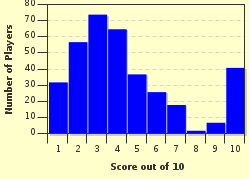Quiz Answer Key and Fun Facts
1. This breed, developed recently in Malaysia, is the smallest breed of chicken (the smallest class cockerel weighs less than 350 grams)
2. Which breed of chicken, developed in France in the early 20th century, is most renowned for its deep chocolate-brown eggs?
3. This breed of chicken was first officially documented in 1352 and has become naturalized in parts of Slovenia and Austria, though it has been near extinction several times. It bears a characteristic crest of feathers pointing back from its comb.
4. This U.S.-developed breed is the largest breed of chicken, with adult cocks weighing in around 13 pounds. It was originally developed to replace turkey production, but due to slow development time to harvest size it has not gained commercial popularity.
5. This breed is the national chicken of Switzerland. Its most noticeable characteristics are a pointed crest and v-shaped comb.
6. This all-purpose breed was developed in the early 1900's to withstand the harsh climate of Canada in winter.
7. This breed is was developed in the last century in the Catalonian region of Spain. It has a carnation comb and lays dark reddish-brown eggs, said to be darker than any other breed. Unlike others developed in the region, this breed comes in black, partridge, wheaten, and crele.
8. This breed is known for its long tail feathers, but unlike other long-tailed breeds, this one is a true bantam variety.
9. This "long-crowing" breed can last up to 25 seconds in "song". It was developed in Japan, and is different from other "long-crowers" by the rooster molting into a winter plumage of a different color than its breeding plumage.
10. These Egyptian chickens differ from others in the region by hens bearing a small back-facing crest and shortened comb.
Source: Author
irshprncsk
This quiz was reviewed by FunTrivia editor
crisw before going online.
Any errors found in FunTrivia content are routinely corrected through our feedback system.


